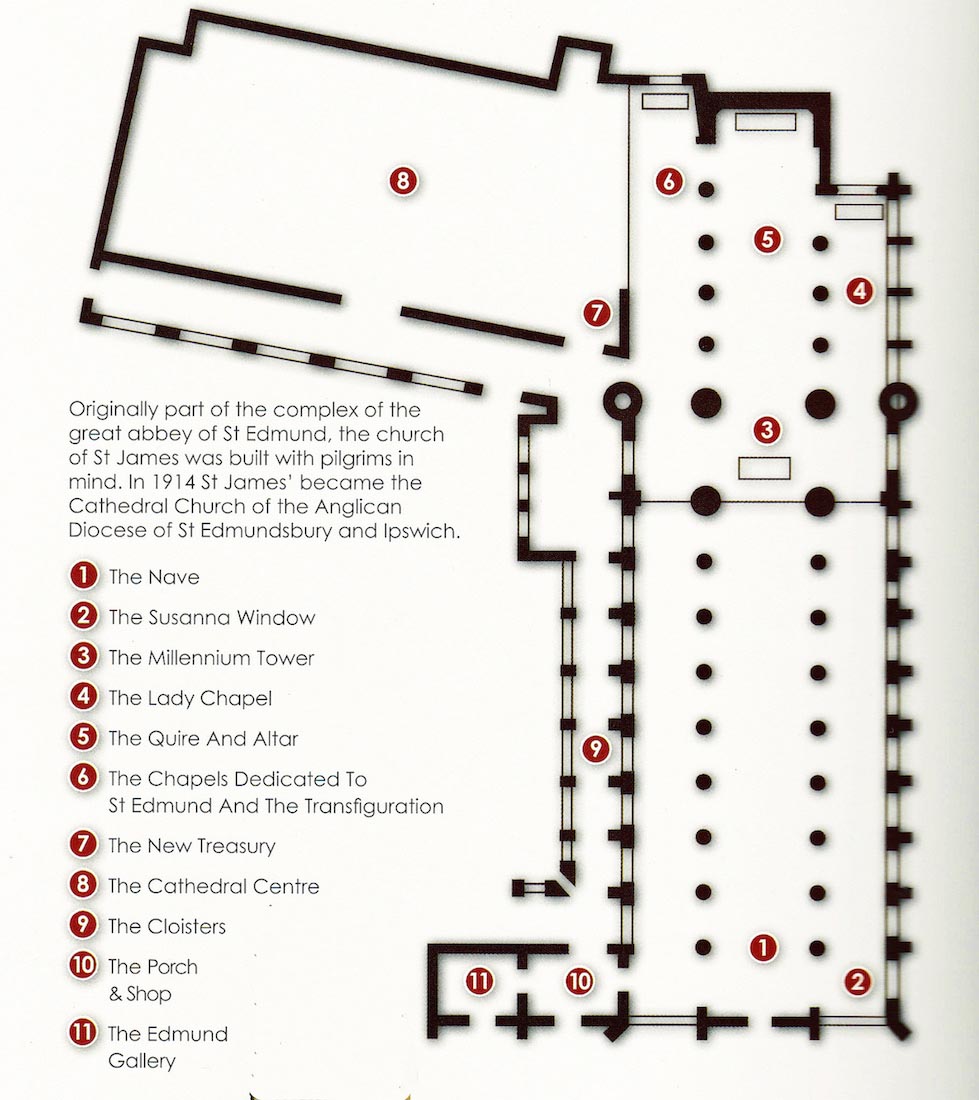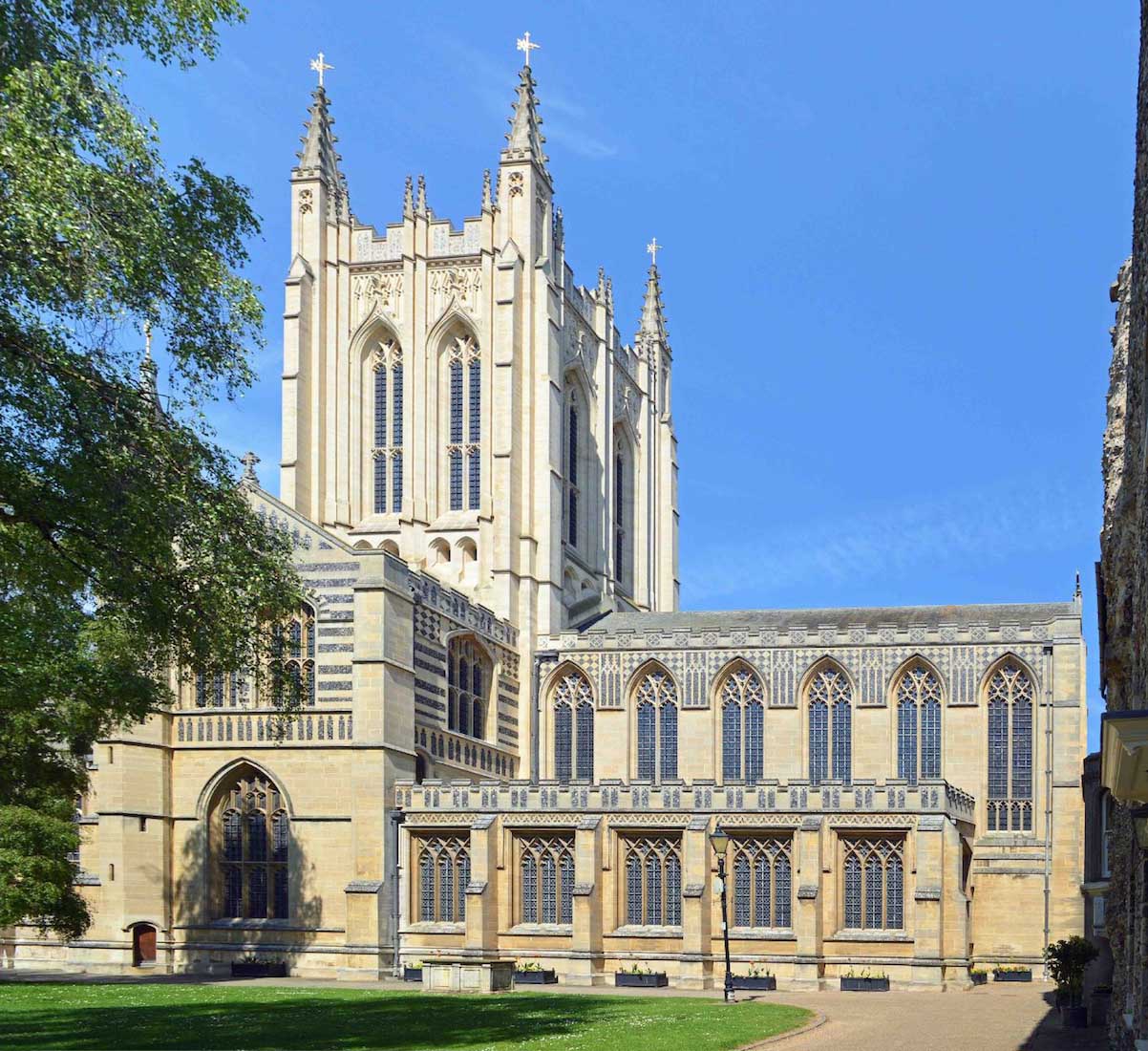ST EDMUNDSBURY CATHEDRAL
BURY ST EDMUNDS ENGLAND
PAUL SCOTT

This is the plan of the Cathedral from the Cathedral publication. Our tour will included these key places, but in a different order. As usual our plan is to walk right around the outside (as far as possible!), and then enter by the entryway 10. From here we explore the interior.
The Cathedral is in fact cruciform in structure, but this is somewhat hidden in the plan, although visible from outside. There is a cloister to the left of the nave.
To continue, start with START
Or you can access intermediate points in the tour by a tap / click on the following links:
NOTE ON MAGNIFYING IMAGES
With this website format the images are large enough for most purposes. If there is a need for greater magnification of an image, go to the identical photo on
https://www.flickr.com/photos/paulscottinfo/albums
and use Command - + (Mac) or Windows - + (Windows).
HISTORY
[Wikipedia]
St Edmundsbury Cathedral (formally entitled the Cathedral Church of St James and St Edmund) is the Cathedral for the Church of England’s Diocese of St Edmundsbury and Ipswich. It is the seat of the Bishop of St Edmundsbury and Ipswich and is in Bury St Edmunds. Originating in the 11th century, it was rebuilt in the 12th and 16th centuries as a parish church and became a cathedral in 1914; it has been considerably enlarged in recent decades.
A church has stood on the site of the cathedral since at least 1065, when St Denis’s Church was built within the precincts of Bury St Edmunds Abbey. In the early 12th century the Abbot, Anselm had wanted to make a pilgrimage along the Way of St James to Santiago de Compostela. He was unsuccessful and instead rebuilt St Denis’s and dedicated the new church to Saint James, which served as the parish church for the north side of Bury St Edmunds. Anselm was also responsible for building the abbey gate tower, known today as the Norman Tower, alongside St James’, which also served as the church’s belfry and it continues in this function to the present day.
This church was largely rebuilt, starting in 1503, in the Perpendicular style by John Wastell, a master mason who also worked on King’s College, Cambridge. Further alterations to the building were undertaken in the 18th and 19th centuries, notably a new chancel and a hammerbeam roof by George Gilbert Scott. When the Diocese of St Edmundsbury and Ipswich was created in 1914, St James’s Church was made the Cathedral. In 1959 Benjamin Britten wrote the Fanfare for St Edmundsbury for a ‘Pageant of Magna Carta’ held in the Cathedral grounds.
From 1959 onwards there was renewed building work designed to transform the former parish church into a cathedral building. Between 1959 and 1970, the Victorian chancel was demolished and replaced with a new quire, and a cloister was added on the west side. Also added were transepts, a Lady Chapel and a side chapel dedicated to St Edmund. The Cathedral architect from 1943 to 1988 was Stephen Dykes Bower and he left £2 million for the completion of the Cathedral. In the Cathedral grounds a new choir school and visitors’ centre were built by Dykes Bower’s successor, Alan Rome; these were opened in 1990. Work started on a Gothic revival style tower in 2000; this was funded by the Millennium Commission, the Stephen Dykes Bower Trust and others. The Millennium Tower was designed by Hugh Mathew, an associate of Dykes Bower. The 150 foot (46 metre) structure was built from 600,000 bricks and faced with Barnack and Clipsham stone. Its completion was officially celebrated on 22 July 2005. Further additions to the Cathedral are the Chapel of the Transfiguration and the East Cloister, both completed in 2009, and the Crypt Treasury which was completed in 2012.



